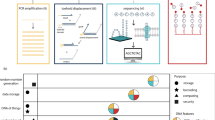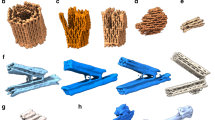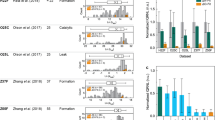Abstract
The common key to nearly all processes involving DNA is the hybridization and melting of the double helix: from transmission of genetic information and RNA transcription, to polymerase chain reaction and DNA microarray analysis, DNA mechanical nanodevices and DNA computing. Selecting DNA sequences with similar melting temperatures is essential for many applications in biotechnology. We show that instead of calculating these temperatures, a single parameter can be derived from a statistical-mechanics model that conveniently represents the thermodynamic equivalence of DNA sequences. This parameter is shown to order experimental melting temperatures correctly, is much more readily obtained than the melting temperature, and is easier to handle than the numerous parameters of empirical regression models.
This is a preview of subscription content, access via your institution
Access options
Subscribe to this journal
Receive 12 print issues and online access
$209.00 per year
only $17.42 per issue
Buy this article
- Purchase on Springer Link
- Instant access to full article PDF
Prices may be subject to local taxes which are calculated during checkout




Similar content being viewed by others
References
Prohofsky, E. W. Solitons hiding in DNA and their possible significance in RNA transcription. Phys. Rev. A 38, 1538–1541 (1988).
Breslauer, K., Frank, R., Blocker, H. & Marky, L. Predicting DNA duplex stability from the base sequence. Proc. Natl Acad. Sci. USA 83, 3746–3750 (1986).
SantaLucia, J. Jr, Allawi, H. T. & Seneviratne, P. A. Improved nearest-neighbour parameters for predicting DNA duplex stability. Biochemistry 35, 3555–3562 (1996).
Owczarzy, R. et al. Predicting sequence dependent melting stability of short duplex DNA oligomers. Biopolymers 44, 217–239 (1998).
Owczarzy, R. et al. Effects of sodium ions on DNA duplex oligomers: Improved predictions of melting temperatures. Biochemistry 43, 3537–3554 (2004).
Pancoska, P., Moravek, Z. & Moll, U. M. Rational design of DNA sequences for nanotechnology, microarrays and molecular computers using eulerian graphs. Nucl. Acids Res. 32, 4630–4645 (2004).
Peyrard, M. & Bishop, A. R. Statistical mechanics of a nonlinear model for DNA denaturation. Phys. Rev. Lett. 62, 2755–2757 (1989).
Dauxois, T., Peyrard, M. & Bishop, A. R. Entropy-driven DNA denaturation. Phys. Rev. E 47, R44–R47 (1993).
Dauxois, T. & Peyrard, M. Entropy-driven transition in a one-dimensional system. Phys. Rev. E 51, 4027–4040 (1995).
Zhang, Y.-L., Zheng, W.-M., Liu, J.-X. & Chen, Y. Z. Theory of DNA melting based on the Peyrard-Bishop model. Phys. Rev. E 56, 7100–7115 (1997).
Campa, A. & Giansanti, A. Experimental tests of the Peyard-Bishop model applied to the melting of very short DNA chains. Phys. Rev. E 58, 3585 (1998).
Theodorakopoulos, N., Dauxois, T. & Peyrard, M. Order of the phase transition in models of DNA thermal denaturation. Phys. Rev. Lett. 85, 6–9 (2000).
Theodorakopoulos, N., Peyrard, M. & MacKay, R. S. Nonlinear structure and thermodynamic instabilities in a one-dimensional lattice system. Phys. Rev. Lett. 93, 258101 (2004).
Cule, D. & Hwa, T. Denaturation of heterogeneous DNA. Phys. Rev. Lett. 79, 2375–2378 (1997).
Blake, R. & Delcourt, S. Thermal stability of DNA. Nucl. Acids Res. 26, 3323–3332 (1998).
Wu, P., Nakano, S. & Sugimoto, N. Temperature dependence of thermodynamic properties for DNA/DNA and RNA/DNA duplex formation. Eur. J. Biochem. 269, 2821–2830 (2002).
Tikhomirova, A., Taulier, N. & Chalikian, T. V. Energetics of nucleic acid stability: The effect of ΔC P . J. Am. Chem. Soc. 126, 16387–16394 (2004).
Wartell, R. M. & Benight, A. S. Thermal denaturation of DNA molecules: a comparison of theory with experiment. Phys. Rep. 126, 67–107 (1985).
Acknowledgements
This work was supported by Research Councils UK through the Basic Technology Programme.
Author information
Authors and Affiliations
Corresponding author
Ethics declarations
Competing interests
The authors declare no competing financial interests.
Rights and permissions
About this article
Cite this article
Weber, G., Haslam, N., Whiteford, N. et al. Thermal equivalence of DNA duplexes without calculation of melting temperature. Nature Phys 2, 55–59 (2006). https://doi.org/10.1038/nphys189
Received:
Accepted:
Published:
Issue Date:
DOI: https://doi.org/10.1038/nphys189
This article is cited by
-
Probing the microscopic flexibility of DNA from melting temperatures
Nature Physics (2009)
-
Melting the double helix
Nature Physics (2006)



